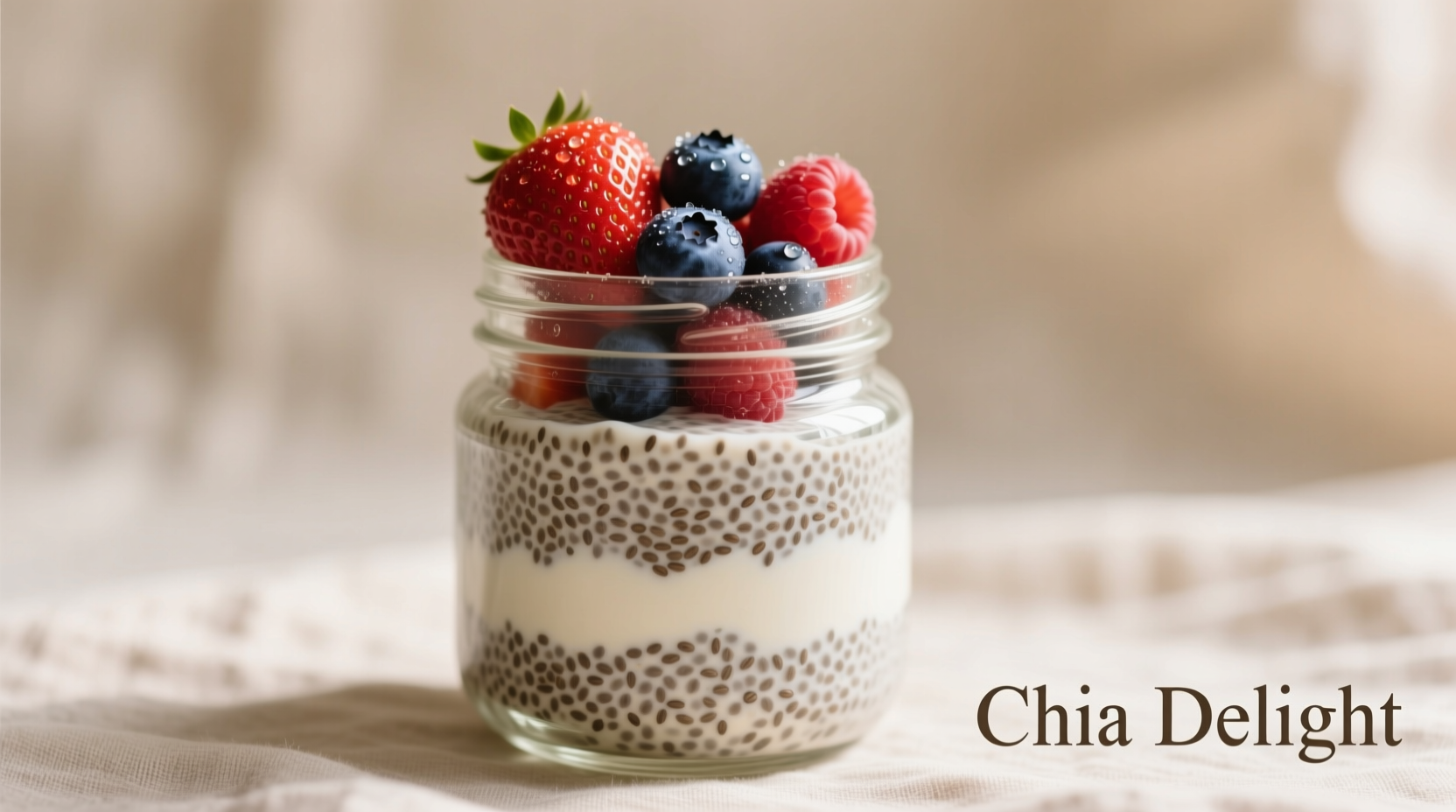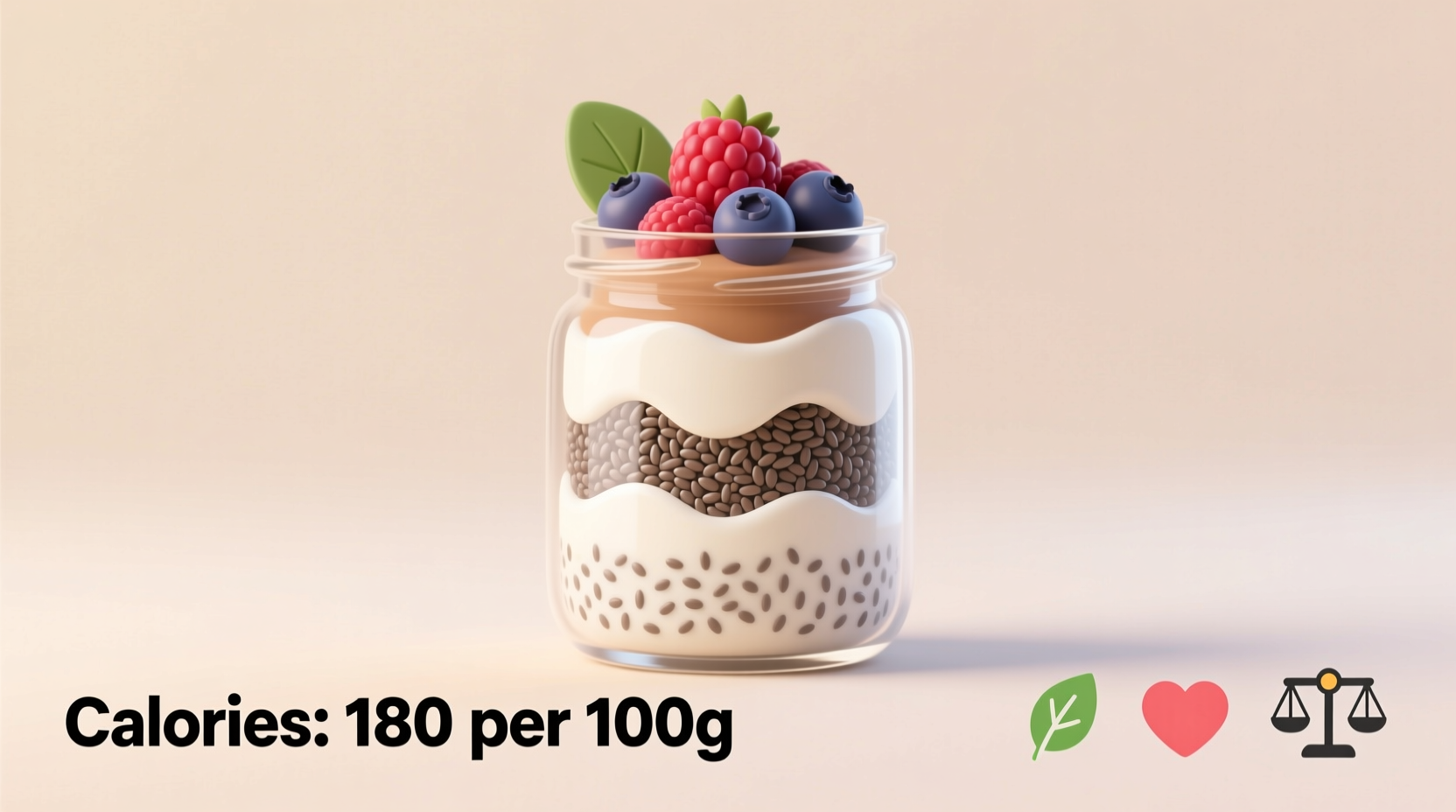Understanding the precise calorie content of chia seed pudding helps you make informed dietary choices whether you're managing weight, tracking macros, or simply enjoying this popular superfood dessert. This guide delivers evidence-based nutritional information you can trust, with practical insights for customizing your pudding to match your health goals.
What Determines Chia Seed Pudding Calorie Count?
Unlike many desserts with fixed recipes, chia seed pudding's calorie content varies dramatically based on your ingredient choices. Let's break down the components that impact the final count:
| Ingredient | Standard Amount | Calories | Key Nutrients |
|---|---|---|---|
| Chia seeds (2 tbsp) | 28g | 138 | 5g protein, 10g fiber, 9g healthy fats |
| Unsweetened almond milk (1/2 cup) | 120ml | 15-20 | 1g protein, calcium, vitamin E |
| Maple syrup (1 tbsp) | 15ml | 52 | Natural sugars, trace minerals |
| Coconut milk (full-fat, 1/2 cup) | 120ml | 180-200 | 5g protein, 18g fat, MCTs |
| Fresh berries (1/4 cup) | 40g | 15-20 | Vitamin C, antioxidants, fiber |
This nutritional breakdown comes from the USDA FoodData Central, the most authoritative source for standardized food composition data. Their comprehensive database shows how each component contributes to the final nutritional profile.
How Your Preparation Method Changes Calorie Content
Two identical-looking chia puddings can have vastly different calorie counts based on preparation choices. Consider these critical variables:
- Liquid base selection: Unsweetened almond milk (20 cal/cup) versus full-fat coconut milk (450 cal/cup) creates a 430-calorie difference per serving
- Sweetener type and amount: Natural sweeteners like dates or maple syrup add significant calories compared to zero-calorie alternatives
- Chia seed ratio: The standard 3:1 liquid-to-seed ratio affects thickness but not calories per serving, though some recipes use more seeds for thicker texture
- Toppings: A tablespoon of nut butter adds 100 calories, while fresh fruit typically adds 15-30 calories per serving
Research published in the Journal of Food Composition and Analysis confirms that recipe variations account for up to 150% difference in calorie content among chia seed pudding preparations. This explains why generic online claims about "chia pudding calories" often mislead consumers.
Why Calorie Count Alone Doesn't Tell the Whole Story
While tracking calories matters for many dietary goals, chia seed pudding offers nutritional advantages that make its calories particularly valuable:
The high fiber content (10g per 28g chia seeds) creates significant satiety, meaning you feel full longer on fewer calories. A 2017 clinical study demonstrated that chia seed consumption reduced hunger hormones more effectively than other common fiber sources.
Unlike processed desserts with empty calories, chia seed pudding delivers:
- Complete plant-based protein (all nine essential amino acids)
- Omega-3 fatty acids (more per ounce than salmon)
- Calcium, magnesium, and phosphorus for bone health
- Antioxidants that combat oxidative stress

Smart Strategies for Managing Calorie Content
Whether you're watching your weight or simply eating mindfully, these evidence-based approaches help you enjoy chia seed pudding without calorie concerns:
- Master portion control: Use 8-ounce mason jars as serving containers—this visually standardizes portions at approximately 1/2 cup
- Choose low-calorie liquid bases: Unsweetened almond milk or cashew milk provide creaminess with minimal calories (20-30 cal/cup)
- Optimize natural sweetness: Blend frozen bananas or dates with your liquid base instead of adding sweeteners
- Strategic topping approach: Add volume with zero-calorie options like cinnamon or vanilla extract before considering higher-calorie toppings
- Batch preparation: Make multiple servings at once using precise measurements to avoid calorie creep from eyeballing ingredients
Nutrition professionals at the Academy of Nutrition and Dietetics recommend viewing chia seed pudding as a nutrient-dense meal component rather than just a dessert. When properly prepared, it can serve as a satisfying breakfast or post-workout recovery food with balanced macronutrients.
How Chia Seed Pudding Compares to Common Alternatives
Understanding relative calorie density helps contextualize chia seed pudding within your overall diet. Here's how it stacks up against popular breakfast and dessert options:
- Standard chia pudding (almond milk base): 150-180 calories per 1/2 cup
- Yogurt parfait with granola: 250-350 calories per cup
- Cream of wheat: 120-150 calories per cup (without additions)
- Chocolate pudding (store-bought): 150-200 calories per serving
- Cheesecake: 350-500 calories per slice
The key differentiator is nutrient density—chia seed pudding delivers substantially more fiber, protein, and healthy fats than most comparable options, enhancing its satiety value per calorie.
Practical Application: Building Your Perfect Calorie-Controlled Pudding
Follow this simple framework to create chia seed pudding matching your specific calorie goals:
For 150-calorie version (ideal for weight management):
2 tbsp chia seeds + 1/2 cup unsweetened almond milk + 1/4 tsp vanilla extract + 1/4 cup fresh berries
For 250-calorie balanced meal option:
3 tbsp chia seeds + 1/2 cup light coconut milk + 1 tsp chia seeds + 1/2 mashed banana + 1 tbsp chopped almonds
For 350-calorie post-workout recovery:
3 tbsp chia seeds + 1/2 cup full-fat coconut milk + 1 scoop plant protein + 1 tbsp cacao nibs + 1/2 cup mixed berries
Registered dietitians at major health institutions like Mayo Clinic emphasize that the quality of calories matters more than the quantity alone. Chia seed pudding's combination of slow-digesting fiber, healthy fats, and complete protein creates metabolic benefits that processed low-calorie alternatives cannot match.











 浙公网安备
33010002000092号
浙公网安备
33010002000092号 浙B2-20120091-4
浙B2-20120091-4